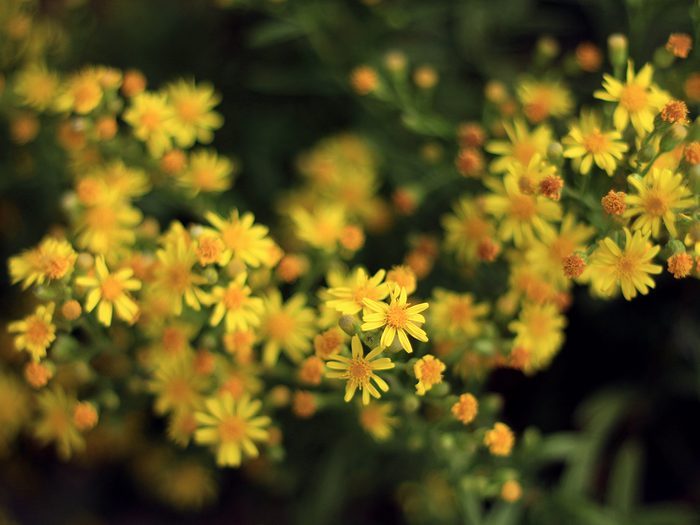Prone to Bruises? Here’s How this Daisy Doppelgänger Can Help You Heal

Arnica montana is a plant that's been used for medicinal purposes for five centuries—but many of us still don’t know anything about it. Here's how it can help reduce swelling, bruises and more.
For many years, my legs were covered in marks and bruises. The lightest graze against an object would turn them black and blue. But recently I tried a cream that promises to quickly remedy scars and bruises, and now my legs are almost completely mark-free. What’s the magical ingredient? It’s just a plant, actually, called arnica montana.
(Related: What the Colour of Your Bruise Is Trying to Tell You)
Arnica isn’t simply another buzzy skin-care ingredient that’s popped up on TikTok (we’re looking at you, snail mucin). This herb, a perennial that features canary-yellow flowers, has been used for medicinal purposes since at least the 1500s. Why? Well, according to Christiane Laberge, a family doctor in Montreal, there’s nothing else—natural or otherwise—quite like it.
Laberge says the superpower of this plant is that it can help accelerate the healing process and is proven to be harmless, as long as it’s used correctly. Arnica isn’t intended to replace conventional and doctor-prescribed medicines, but is instead used alongside them to help alleviate discomfort. Still, not that many people in Canada and the U.S. know about it.
In France, 40 percent of doctors prescribe it regularly to treat bruising and swelling, says Laberge. But in Canada, doctors can only suggest it. Although Health Canada reviews all homeopathic products (like arnica) that are available in the country to make sure they’re safe, doctors are only able to prescribe therapies recognized by evidence-based protocols or results supported by scientific societies, says Laberge. “However,” she adds, “in cases where conventional medicine has nothing to offer in terms of a cure, doctors can suggest certain homeopathic substances.”
Arnica can be used in two ways: as a topical treatment or as a diluted oral remedy. As a topical, it comes in the form of a cream or ointment that can be applied to the skin to treat bruises as well as sprains, sore muscles, wounds, inflammation from insect bites and swelling from broken bones. All you need to do is apply it up to three times a day to the tender area and repeat for a few days until the mark or discomfort fades.
As a diluted oral remedy, it comes in capsules to swallow or tiny sweet-tasting pellets to dissolve under the tongue. Like the cream, these supplements can help treat sore muscles, bruises and swelling and can be taken as frequently as needed, lessening the dose as the pain is soothed. (Arnica in plant form is risky to consume, which is why homeopathic supplements are extremely diluted and therefore considered safe.)
Although arnica can’t be prescribed by doctors in Canada, some highly recommend it, including plastic surgeons. “When it’s taken orally, it helps reduce inflammation, bruising and swelling, which all lead to pain,” says Jamil Ahmad, a plastic surgeon in Mississauga. What that means is that fewer—or no—additional pain medications may be required to soothe discomfort. Ahmad says he and the other doctors in his clinic recommend arnica in part to reduce patients’ need for narcotics like OxyContin or Percocet, particularly because they’ve been overprescribed, overused and shown to be highly addictive. In some cases, patients can alleviate their post-operative pain with a combination of acetaminophen (a.k.a. Tylenol) and arnica.
Surgery patients who use arnica supplements typically take them before their procedure and immediately after, until the discomfort subsides. “That helps to reduce the onset of swelling, or the development of swelling, and also helps address it once it’s there,” says Ahmad. Topical arnica can be used immediately after surgery to help reduce bruises and swelling in areas without any open wounds. For example, it’s sometimes recommended before and after rhinoplasty to help heal bruising and swelling around the eyes and nose. And it really works—a 2019 study by the Annals of Plastic Surgery saw a decrease in postoperative swelling for patients who used arnica after surgery on the nose.
Arnica should be used according to the directions on the label, or following the advice of your practitioner. The capsules come in different forms, such as 6c, 15c and 30c (the “c” standing for Hahnemannian centesimal scale unit of dilutions)—the higher the number, the stronger the supplement, making it better suited for more severe discomfort. While arnica cream or ointment may cause skin irritation, it’s extremely rare.
Ahmad says that he routinely prescribes oral arnica to patients undergoing surgery, and sometimes prescribes topical arnica. In his 13 years of practicing at his clinic, which sees about 1,000 patients annually, Ahmad says he’s never dealt with any adverse reaction from either form of arnica.
Arnica topicals and supplements are available at most Canadian health food stores and pharmacies. My own go-tos are from French company Boiron—it makes all its products in a factory located just outside of Lyon, using freshly harvested arnica. Today, I try to always keep arnica cream or pellets nearby—just in case a table leg or bedpost jumps in my path, again.
Laberge is a convert, too. “I always have it in my purse.” Whenever she has a small accident, Larberge takes a few arnica pellets immediately to help reduce pain, inflammation and other trauma from the injury. “Is it 100 percent effective at reducing pain? I would say no, but it helps,” she says.
Next: These All-Natural Home Remedies Can Help Boost Your Energy




